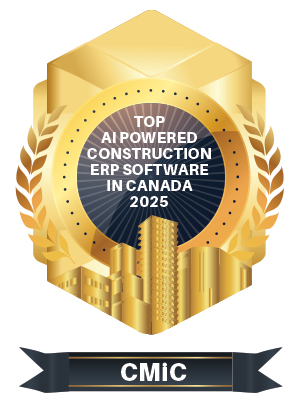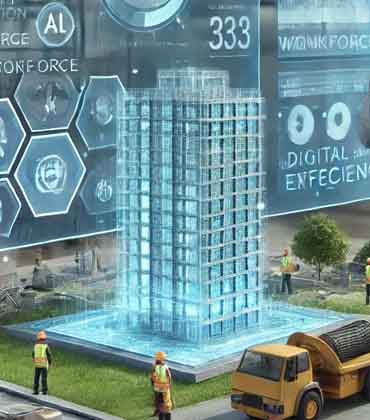THANK YOU FOR SUBSCRIBING
For years, AI in industries like construction was boxed into a narrow role, akin to a technology expert. It crunched numbers, dissected data, churned out forecasts, and generated reports. While it was undoubtedly useful, its capabilities remained limited. It could tell you what happened or what might, but never helped to do anything about it. Users were left to go on a digital hunt, manually digging through projects, spreadsheets, and siloed systems just to feed the machine. The interface was clunky, and the interaction was non-existent. This made the human-machine relationship static and one-sided, anchored to keyboards, screens, and the constant friction of complexity. That’s no longer the case. Leading firms are embracing a new class of ERP platform that doesn’t just centralize data but understands it, adapts in real time, responds, and thinks. At the forefront of this shift is CMiC, the leading fully AI-powered ERP in market that’s engineered for the way construction works today. Purpose-built for the industry, its AI-powered suite supports integrated project delivery, simplifies workflows, and strengthens office-to-field communication. Developed entirely in-house using a single code base, CMiC’s platform ensures uniform data flow across applications. The company also maintains a strong integration partner ecosystem that enhances the platform’s capabilities and service offerings. “Innovation drives everything we do. We equip firms with powerful tools that turn data into action, helping them make smarter decisions, streamline operations, and boost productivity,” says Jeff Weiss, Chief Revenue Officer—CMiC. At the heart of CMiC’s ERP is a suite of modules, including Financials & Accounting, Project Controls, Project Management & Collaboration, Enterprise Content Management, Enterprise Planning, Human Capital Management, Asset Management and Mobile Field. What truly sets the platform apart is its revolutionary user experience. By using natural language as the primary interface, the system eliminates the need for complex navigation or detailed data entry. Users can speak to an AI agent to request forecasts, generate reports, or initiate transactions, and the system responds in real time, intelligently executing tasks and updating records. Every user is supported by a personalized AI agent that learns from their distinct behavior and preferences. This agent understands the business context and can proactively suggest next steps. Tasks that once required repetitive manual effort like running payroll, uploading documents, or generating reports can now be automated and recalled on demand through simple, natural language prompts.
Top Road Construction Collaborative Platform in Canada 2025
When it comes to quantitative data, there is no shortage of apps on a jobsite. One logs crew hours, another tracks fuel consumption, and a third flags a late asphalt delivery. Yet none tell you the one thing that matters most: how well the road is actually being built. The moment you ask a site manager about qualitative information, real-time data vanishes, dashboards give way to clipboards, spreadsheets scatter across desks, and you find yourself back on the phone with the lab. DAWAY closes that blind spot in quality control. DAWAY changes that. Built specifically for the quality control side of road construction, DAWAY is a smart, role-based SaaS ecosystem that gives every stakeholder—from field technicians to general managers—real-time visibility into the materials, measurements, and decisions that determine long-term performance. Whether you’re making snap decisions on-site or planning next year’s mix design based on this year’s results, DAWAY turns quality control into a shared, data- driven process that helps teams build better roads—faster and smarter. “We designed DAWAY as an ecosystem where every player— from lab techs to managers—has the tools and data they need to act in real time. It’s about empowering each role with clarity and keeping the whole operation in sync,” says Guylaine Caux, CEO of DAWAY. Field-Driven and Role-Centric System At its core, DAWAY consists of two primary components: field modules and role-based dashboards. The field modules allow everyone—from lab technicians to jobsite supervisors—to input georeferenced data in real time, eliminating the lag and errors of traditional paper workflows. Whether it’s compaction measurements, thermography data, or material test results, everything flows directly from the site into the ecosystem. Meanwhile, dashboards are automatically populated with analyzed data tailored to each user’s function. A lab technician might see detailed mix design feedback, while a technical director can cross-reference lab, production, and jobsite data to catch quality issues before they escalate. A general manager, on the other hand, gets a project-wide overview and can monitor performance, progress, and productivity at a glance. DAWAY brings clarity without complexity, helping the entire operation stay proactive and potentially reduce litigation?
CXO INSIGHTS

The Transformative Effects of AI in Construction
Jeff Walter, Digital Transformation Leader, AECOM

Paramount Shift in Canadian Construction Industry With Integration of BIM & GIS
Nolan Porther, Senior Geospatial Manager, Aecon Group Inc

The Human Factor in the Digital Transformation of the Construction Industry
Frédéric Leclair, Senior Director, Drafting Services, Cana

BIM 7D Asset Information Modeling: Realizing the Full Potential of VDC
Federico Pensa, Vice President of Technology, Fayolle Canada Inc

Pioneering Tech Innovation in Prefabricated Construction
Geneviève Filteau, Director of Marketing, Honco Group

Crafting Success in Construction
Joel Victoria, Senior Construction Manager, Colliers

The Crossroads
Justin Furey, Project Manager, icon Mechanical
IN FOCUS
EDITORIAL
Digital Tools Power Canada’s Infrastructure
Not long ago, the idea of a fully connected and intelligent construction industry in Canada seemed like a vision for the distant future. Project data was scattered, schedules were often reactive, and road construction depended heavily on manual coordination and guesswork. That reality is beginning to shift. Two emerging technologies are quietly reshaping how Canada designs, builds, and maintains its infrastructure. One brings intelligence and foresight to every stage of construction. The other creates a unified space where teams, equipment, and municipalities can work together with clarity and speed. AI-powered construction ERP software is no longer just about managing spreadsheets or tracking budgets. It combines predictive analytics, realtime cost insights, and automated scheduling to anticipate challenges before they disrupt a project. From urban developments in Toronto to remote highway expansions in Yukon, it gives every stakeholder a single, reliable source of truth. Collaborative road construction platforms are also transforming the way large-scale projects come to life. By integrating live traffic data, weather conditions, and equipment availability, these platforms streamline planning, bidding, and on-site execution. Information moves in real-time, keeping contractors, crews, and city planners aligned and proactive. The most powerful change happens when these technologies work together. ERP systems provide the data needed for smarter road planning, while collaborative platforms enhance the predictive capabilities of ERP tools. Together, they create a construction ecosystem that is faster, more transparent, and better prepared for the demands of tomorrow. In this edition, we spotlight insights from Justin Furey, Project Manager at icon Mechanical, who shares his perspective on how digital tools and collaborative thinking are shaping the future of infrastructure in Canada. We hope that the valuable insights from industry leaders and the solutions and services featured in this edition will assist you in making informed decisions for your business.

 Copyright © 2025 All Rights Reserved | by:
Copyright © 2025 All Rights Reserved | by: Construction Tech Review
| Subscribe | About us | Sitemap| Editorial Policy| Feedback Policy









